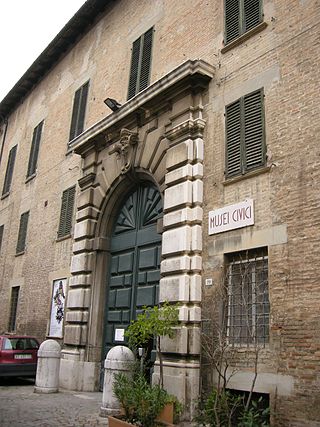
Mariano Fortuny y Madrazo was a Spanish polymath, artist, inventor and fashion designer who opened his couture house in 1906 and continued until 1946. He was the son of the painter Mariano Fortuny y Marsal.
Fortuny is a surname of Catalan origin. It may refer to:

The Museo Correr is a museum in Venice, northern Italy. Located in St. Mark's Square, Venice, it is one of the 11 civic museums run by the Fondazione Musei Civici di Venezia. The museum extends along the southside of the square on the upper floors of the Procuratorie Nuove. With its rich and varied collections, the Museo Correr covers both the art and history of Venice.

Luigi De Giudici was an Italian painter of the Venetian anti-academic movement in the first years of the twentieth century. His works were exhibited at Ca' Pesaro between 1912 and 1920 and at the International Exposition of Paris (1937).

Museo di Storia Naturale di Venezia is a museum of natural history housed in Fondaco dei Turchi, located on the Grand Canal, Venice, Italy. Its collections relate mainly to the natural history of the Venetian lagoon that surrounds the city. Today it is one of the 11 venues managed by the Fondazione Musei Civici di Venezia.

Ettore Tito was an Italian artist particularly known for his paintings of contemporary life and landscapes in Venice and the surrounding region. He trained at the Accademia di Belle Arti in Venice and from 1894 to 1927 was the Professor of Painting there. Tito exhibited widely and was awarded the Grand Prize in painting at the 1915 Panama–Pacific International Exposition in San Francisco. In 1926 he was made a member of the Royal Academy of Italy. Tito was born in Castellammare di Stabia in the province of Naples and died in Venice, the city which was his home for most of his life.

The Palazzo Barbarigo Minotto is a 15th-century palace on the Grand Canal in Venice, northern Italy, next to the much larger Palazzo Corner. Built in the Venetian Gothic style, it was originally two palaces, Palazzo Barbarigo and Palazzo Minotto, later joined together. The Barbarigo palace was owned by the Barbarigo family for several centuries and was the birthplace of Gregorio Barbarigo, who once refused the Papal Crown. It was later owned by the Minotto and Martinengo families.

The Museo di Palazzo Mocenigo is a palazzo near the Church of San Stae, south of the Grand Canal in the sestiere of Santa Croce in Venice, Italy. It is now a museum of fabrics and costumes, run by the Fondazione Musei Civici di Venezia.

The Murano Glass Museum is a museum on the history of glass, including local Murano glass, located on the island of Murano, just north of Venice, Italy.
Founded following the resolution passed by the Municipal Council Board of Venice on March 3, 2008, the Fondazione Musei Civici di Venezia (MUVE) manages and develops the cultural and artistic heritage of Venice and islands. Formed as a participatory foundation, it has only one founding member, the City of Venice.

Giuseppe Amisani was an Italian portrait painter of the Belle Époque.
Museo Civico may refer to:

Ricardo Federico de Madrazo y Garreta was a Spanish painter from the Madrazo family of artists, best known for his Orientalist works. He was also the brother-in-law of the great Spanish Orientalist, Mariano Fortuny, who would be a major influence on both his life and work.

Woman at the Café is a 1931 painting by the Italian artist Antonio Donghi. It depicts a lone woman at a café table.
Gabriella Belli is an Italian art historian and curator, currently director of the Foundation for the municipal museums of Venice .

(Adèle) Henriette Negrin,, born on October 4, 1877, in Fontainebleau, died in 1965 in Venice, was a French clothes-designer and textile artist. She created fabrics and clothes, working alongside her husband Mariano Fortuny.

The Civic Museum of Palazzo Mosca is the main civic museum of Pesaro, displaying art and decorative works, located in Piazza Mosca in this town of the region of the Marche, Italy.

The Palazzo Pesaro Orfei or Palazzo Pesaro degli Orfei is a historic palace in Venice, in northern Italy. It was built by the Pesaro family in the fifteenth century in Venetian Gothic style. From 1902 it was the home of Mariano Fortuny and his wife Henriette Negrin. It now houses the Museo Fortuny, and may also be called Palazzo Fortuny.






















